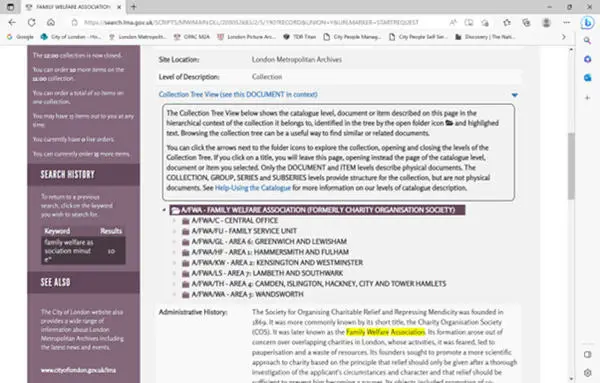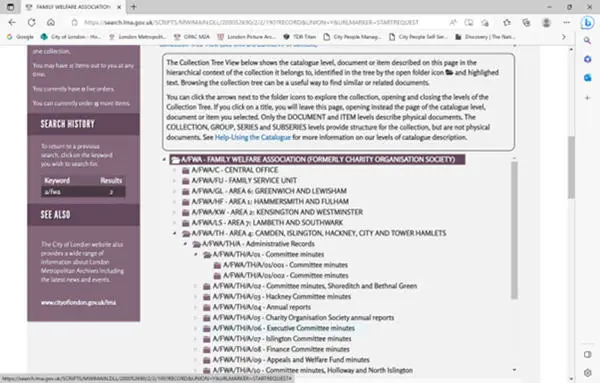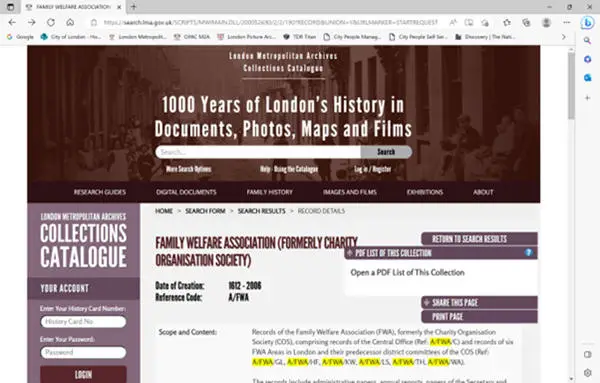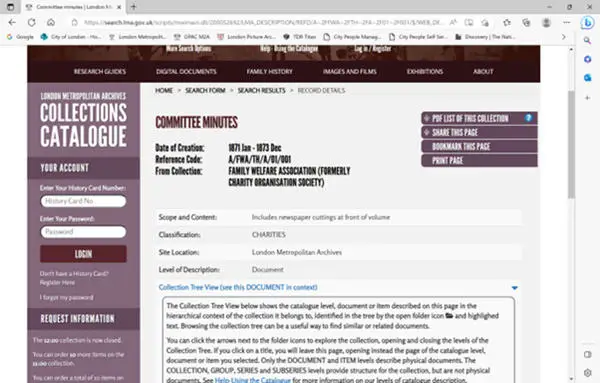Top tips at LMA
Searching the LMA Catalogue
This Top Tip deals with the nature of archival cataloguing and the problems and pitfalls it can cause when searching the London Metropolitan Archives (LMA) catalogue. The ‘Help - Using the Catalogue’ option under the ‘Search’ box at the top of the Catalogue page also contains some of this information - just scroll down to ‘How we organise the archives’
Unlike library books which stand on their own, archival items can only be understood in relation to other documents within the same collection. For example, a set of minute books may have been created by a specific team within a specific department of a large organisation and the team, department and organisation will all have created many other types of record in the course of business which may have a direct or indirect bearing on the information in the minutes. One of these minute books can therefore only be put into context if a researcher knows which organisation, department and team it originated from.
This is the basic premise of archival cataloguing, which is necessarily hierarchical as it sometimes needs to describe large numbers of items in relation to each other, and to address questions such as ‘who created these items, which team, which department’, ‘why were they created’, ‘what else did that team create’?
There will be a number of different levels within the hierarchy, which can be seen in terms of a family tree, with the organisation at the top, followed by its departments, then maybe teams within that department, then different series or types of records created by that team, then finally the individual volumes or files within that series. All of our catalogues at LMA are arranged in this way and we use between three and six levels of the ‘tree’ for every catalogue we produce, depending on the complexity of the creating organisation.
The levels we use are as follows:
- Collection. The record describing the overall creating organisation
- Group. Usually a Department within the organisation, only used for more complex collections
- Series. Often a type of record such as ‘minutes’, ‘ledgers’ etc or a Team/Section within a Department
- Sub-series. Only used with complex collections, again for individual creating sections or types of record
- Document. The main ‘producible unit’ which can be ordered from our strongrooms, usually an individual file, bundle or volume, box of photographs or map
- Item. Used when we have catalogued a specific Document to a more detailed degree, for example when photographs within an album have been individually listed
This hierarchical method of cataloguing can be difficult to translate into a searchable electronic format, because different pieces of information are held at different levels in an organisation’s ‘family tree’ and most software is unable to search more than one level at a time. For example, if someone is looking for a minute book for the Finance Committee of the Camden branch of the Family Welfare Association and they enter ‘Family Welfare Association Camden Finance minute book’ into the Simple Search box on our catalogue, they would get no hits. This is because that information is available in our catalogue at three different levels and the software is unable to put the three levels together in one search. The information concerning the Family Welfare Association sits at one level, records created by the branch area covering Camden are at the next level down and the Finance Committee minutes sit at a lower level as one of the many types of administrative records created by that branch.
The easiest way to navigate the LMA catalogue, and minimise this particular issue with hierarchical cataloguing, is to start your search with the creating organisation and then use the Collection Tree View to navigate to the document you require. So, using the same example, searching for Family Welfare Association will bring up the collection level record for the whole of that organisation. Scrolling down to the Collection Tree View, you can see information in a ‘tree’ format, of the eight sections of the Association’s catalogue, as in this screen shot:

You can then open a branch of the tree by clicking on the white arrow to the side of the branch, to continue navigating down the levels. Clicking on the A/FWA/TH branch will open up the next level for Area 4, Camden, Islington, Hackney, City and Tower Hamlets. Keep opening the branches until you reach a level which has no white arrows by the side of its entries – this means you have reached the bottom of the catalogue. The screen shot below shows the Administrative Records branch of Area 4 (Camden et al) opened to show series of minutes, annual reports, etc and the Committee Minutes series opened in turn to show two individual volumes of committee minutes.

Clicking on the title or reference code of one of those volumes will take you into the catalogue record for that volume, from where you can order it to view, if it is available.
Don’t forget that you can choose to view the full catalogue of an organisation in pdf form, as if it was a paper catalogue. To do this, stay within the top, Collection level record, and choose the ‘PDF list of this collection’ option from the menu at the top left, as in the following screen shot:

The hierarchical method of cataloguing may also cause confusion when searching for more general terms, as you may find that the results returned are at various levels and have been taken from the ‘trees’ of several collections. A search on ’Smithfield Market’ for example, will return hundreds of results, at Collection, Group, Document and Item level, for many different collections. We have tried to make this easier for you by always telling you which level a record is at, and also which collection it is from, ie its ultimate creating organisation, see the following screen shot for these two pieces of information for our Camden area minute book (under 'from collection' and 'Level of Description'):

It is important to remember that you can only order a record which is described as being at the ‘Document’ level. This is because catalogue entries at Collection, Group, Series or Sub-series may, of course, relate to dozens, hundreds or even thousands of documents. Conversely, records at Item level may be bound into volume or album form and naturally we cannot produce less than a whole volume or album. You can use the Collection Tree View to navigate down to Document level from a higher level, or up to Document level if you find yourself at Item level.
We want you to be able to access LMA’s collections as smoothly as possible so if you have any specific queries relating to the catalogue, please contact us through the enquiry form on our website.